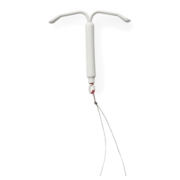Gold-standard birth control: The IUD and the implant
More research shows long-acting reversible methods to be...freakin' awesome, basically.

In terms of effectiveness, not all birth control methods are created equal. And if there was any doubt as to which methods stand out in that arena, an article by the folks behind the Contraceptive CHOICE Project (just published in the New England Journal of Medicine) should put it to rest.
The Contraceptive CHOICE Project, a groundbreaking initiative by researchers at Washington University in St. Louis, offered women in the St. Louis region access to any kind of birth control they wanted for free (swoon, right?), then looked at what method(s) the participants chose and how well their choices worked for them. The researchers found that when cost and lack of information aren’t an issue, women are way more likely to choose a super-effective method of birth control like the IUD or the implant—in fact 75% of the project’s participants chose one of those methods. This is great news since the researchers also found that those methods are way less likely to fail than other methods. Intrigued yet? Let us tell you more:
Participants using the pill, the patch, or the ring were 20 times more likely to have an unintended pregnancy than participants using the IUD, the implant, or the shot. About one in 11 pill, patch, and ring users got accidentally pregnant during the study; fewer than 1 in 100 IUD and implant users got pregnant during that time.*
Younger women (those under 21) were much more likely to have trouble using the pill, the patch, or the ring effectively. They were almost twice as likely to have an unintended pregnancy while using those methods compared to their 21-and-over counterparts.
Study participants were a selected group (not a randomized trial). That said, they were a large group (to the tune of 7,486), and diverse.
The study results found the same level of effectiveness for the IUD and implant as we list on Bedsider, which come from the National Survey of Family Growth.
The shot was found to work just as well as the implant and the IUD, but the researchers only counted people who used it consistently, so their rates represent perfect use rather than typical.
The bottom line? Methods like the implant and the IUD are special because they’re so, so low-maintenance. Women who use them are much more likely to stick with them than with higher-maintenance methods like the pill, the patch, and the ring. They require a little more effort up front—a visit to the health care provider and possibly a higher initial cost—but, for most women, the long-term benefit is well worth it.
We think senior study author Jeffrey Peipert, MD, said it best: “If there were a drug for cancer, heart disease or diabetes that was 20 times more effective, we would recommend it first.” Hopefully health care providers will take the cue, but in the meantime, you can take the initiative by learning more about the implant and the IUD and talking to your provider about your options.
*Editor’s Note: A previous version of this article incorrectly reported the failure rates for the birth control methods tracked in the study. We fixed the error and apologize for any confusion.
How do you feel about this article?

Heat up your weekends with our best sex tips and so much more.

